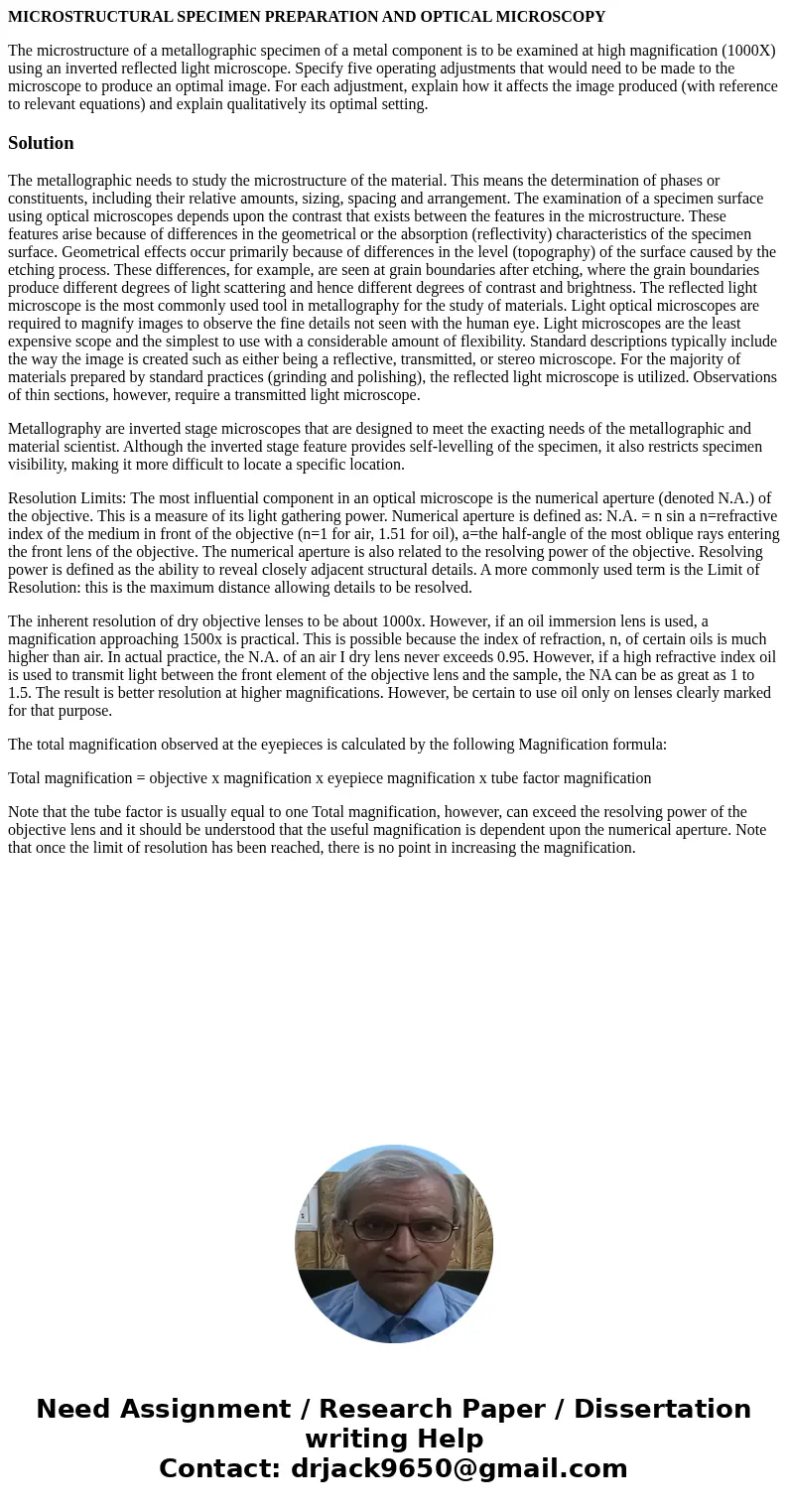MICROSTRUCTURAL SPECIMEN PREPARATION AND OPTICAL MICROSCOPY
MICROSTRUCTURAL SPECIMEN PREPARATION AND OPTICAL MICROSCOPY
The microstructure of a metallographic specimen of a metal component is to be examined at high magnification (1000X) using an inverted reflected light microscope. Specify five operating adjustments that would need to be made to the microscope to produce an optimal image. For each adjustment, explain how it affects the image produced (with reference to relevant equations) and explain qualitatively its optimal setting.
Solution
The metallographic needs to study the microstructure of the material. This means the determination of phases or constituents, including their relative amounts, sizing, spacing and arrangement. The examination of a specimen surface using optical microscopes depends upon the contrast that exists between the features in the microstructure. These features arise because of differences in the geometrical or the absorption (reflectivity) characteristics of the specimen surface. Geometrical effects occur primarily because of differences in the level (topography) of the surface caused by the etching process. These differences, for example, are seen at grain boundaries after etching, where the grain boundaries produce different degrees of light scattering and hence different degrees of contrast and brightness. The reflected light microscope is the most commonly used tool in metallography for the study of materials. Light optical microscopes are required to magnify images to observe the fine details not seen with the human eye. Light microscopes are the least expensive scope and the simplest to use with a considerable amount of flexibility. Standard descriptions typically include the way the image is created such as either being a reflective, transmitted, or stereo microscope. For the majority of materials prepared by standard practices (grinding and polishing), the reflected light microscope is utilized. Observations of thin sections, however, require a transmitted light microscope.
Metallography are inverted stage microscopes that are designed to meet the exacting needs of the metallographic and material scientist. Although the inverted stage feature provides self-levelling of the specimen, it also restricts specimen visibility, making it more difficult to locate a specific location.
Resolution Limits: The most influential component in an optical microscope is the numerical aperture (denoted N.A.) of the objective. This is a measure of its light gathering power. Numerical aperture is defined as: N.A. = n sin a n=refractive index of the medium in front of the objective (n=1 for air, 1.51 for oil), a=the half-angle of the most oblique rays entering the front lens of the objective. The numerical aperture is also related to the resolving power of the objective. Resolving power is defined as the ability to reveal closely adjacent structural details. A more commonly used term is the Limit of Resolution: this is the maximum distance allowing details to be resolved.
The inherent resolution of dry objective lenses to be about 1000x. However, if an oil immersion lens is used, a magnification approaching 1500x is practical. This is possible because the index of refraction, n, of certain oils is much higher than air. In actual practice, the N.A. of an air I dry lens never exceeds 0.95. However, if a high refractive index oil is used to transmit light between the front element of the objective lens and the sample, the NA can be as great as 1 to 1.5. The result is better resolution at higher magnifications. However, be certain to use oil only on lenses clearly marked for that purpose.
The total magnification observed at the eyepieces is calculated by the following Magnification formula:
Total magnification = objective x magnification x eyepiece magnification x tube factor magnification
Note that the tube factor is usually equal to one Total magnification, however, can exceed the resolving power of the objective lens and it should be understood that the useful magnification is dependent upon the numerical aperture. Note that once the limit of resolution has been reached, there is no point in increasing the magnification.

 Homework Sourse
Homework Sourse